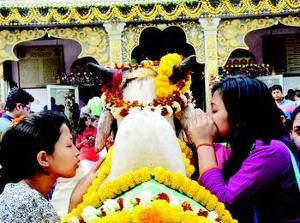
We’ve all heard about tree houses, but what about tree-temples? Well, such a rare heritage tree-temple does exist in our very own Visakhapatnam district in the tribal village of Kasipatnam near Tyda, enroute Araku Valley.
Encapsulated within the centuries old roots of a banyan tree, an even more ancient Shiva temple stands erect, its ageing bricks and tales of locals bearing testimony to it dating back to at least 300-400 years.
Located nearly 110 km from the city amid serene and verdant hills and near a little river, the Kasipatnam Ramalingeshwara Temple draws around 15-20 people daily from nearby villages. According to locals, on festive occasions such as Nagulachavithi, Karthikamasam and Mahasivaratri, hundreds turn up to offer prayers to the siva lingam. Strangely, the thick roots of an ancient banyan tree have locked within it the little temple that has a conical-shaped dome and structure made of small bricks.
The nearly 85-year-old Doddi Ramulamma, who has been looking after the temple since childhood, said, “My family has been serving the temple since it was discovered. My forefathers served the temple and this tradition was passed on from generation to generation. To fulfill the basic requirements of the temple and my family, I sell printed entry tickets (priced Rs 10 per visitor) provided by villagers. My husband, two sons and one daughter are all dead but I have two grandchildren. During Shivaratri and Nagaulachavithi, lots of people from various places come to visit the temple.”
People living here believe that prayers of devotees who visit the temple never go in vain. A popular instance being that of Pitala Govindraju from Gajuwaka. The childless man offered prayers to the temple and soon was blessed with two children. As an act of gratitude, he added new structures to the temple, such as steps and tiles on the interior walls of the sanctum sanctorum.
Though nobody knows the exact date of the temple’s construction, tribals believe that it came into existence naturally. However, some of the little educated among them say it was built more than 400 years ago going by the bricks used in construction and the aged banyan tree, which grew around the temple, pointed out another local Doddi Dharma.
Prior to cyclone Hudhud, the tree was huge and even more sprawling but due to the impact of the cyclone, most of its branches were broken. Though the structure of the ancient temple was resilient enough to withstand the ravages of time and that of the cyclone, it deserves conservation as an archaeological and natural heritage site.
However, the state department of archaeology is clueless about this temple. AP State Department of Archaeology and Museums assistant director K Chitti Babu said, “Such a rare tree-temple deserves protection but we haven’t seen it yet. We will visit the temple at Kasipatnam and try to ascertain its age from statues, deities and inscriptions.”
Meanwhile, Intach (Indian National Trust for Art and Cultural Heritage) member and environment activist Sohan Hatangadi, who had earlier visited the tree-temple, suggested the involvement of APTDC (AP Tourism Development Corporation) and state archaeology department along with locals for preservation of the temple and tree.
“It’s a unique example of a combined natural and manmade heritage site, which is easily 300-400 years old or even more. APTDC should put up signages at the site, while Intach can document the temple. Since it’s a religious place, locals should also be involved in the form of a cooperative to take care of the temple and generate revenue for the family looking after the temple. Also, some cleaning, light fencing around the tree-temple, garbage disposal and parking provisions away from the temple should be made. The side road through the village leading to the temple should also be repaired. One should ensure that the centuries-old heritage site doesn’t turn into a picnic spot for revelers in the name of tourism. Rather, the archaeological and natural heritage site needs to be preserved the best way possible,” suggested Hatangadi.
source: http://www.timesofindia.indiatimes.com / The Times of India / News Home> City> Visakhapatnam / TNN / August 16th, 2015